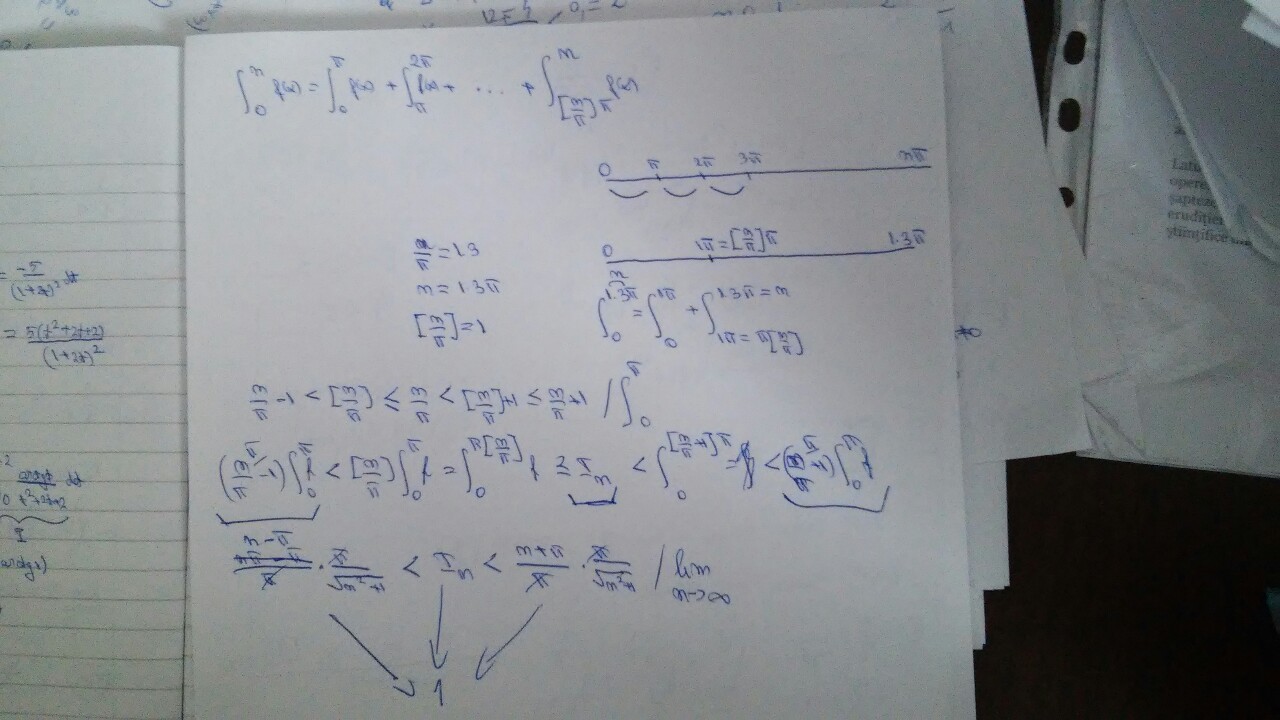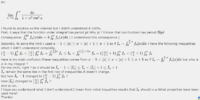You are using an out of date browser. It may not display this or other websites correctly.
You should upgrade or use an alternative browser.
You should upgrade or use an alternative browser.
integral confusion
- Thread starter Vali
- Start date
Steven G
Elite Member
- Joined
- Dec 30, 2014
- Messages
- 14,603
1st, the cos function does not have a period of 2kpi. The period of cos is a constant while 2kpi varies as k changes. Yes, it is true that cos(x) = cos(x+2kpi) but that is because the period of cos is 2pi (not 2kpi).
Just look at the graph of cos2(x) and tell me what the period is
2ndly, there is no function under the integral. I looked but did not see one. I suspect that you meant the denominator of the integrand.
I gave you a hard time with the two comments above because I want you to learn to speak mathematically.
The consequence will be true if the period of fn(x) was pi.
You say that I have the following inequalities which I did not understand completely. There is a long string of inequalities can you please tell us which one(s) you did not understand? They mostly come from the line above.
No, x does not equal In. They clearly defined In. In may be a function of x but why x itself?
Just look at the graph of cos2(x) and tell me what the period is
2ndly, there is no function under the integral. I looked but did not see one. I suspect that you meant the denominator of the integrand.
I gave you a hard time with the two comments above because I want you to learn to speak mathematically.
The consequence will be true if the period of fn(x) was pi.
You say that I have the following inequalities which I did not understand completely. There is a long string of inequalities can you please tell us which one(s) you did not understand? They mostly come from the line above.
No, x does not equal In. They clearly defined In. In may be a function of x but why x itself?
Dr.Peterson
Elite Member
- Joined
- Nov 12, 2017
- Messages
- 16,865
Perhaps it would be helpful if you gave us a link to the solution you found, so we could see the whole thing, and you could focus on the specific points you don't understand. When you say "I used", I suppose "I" means the person who wrote that solution?
Presumably they are using [x] to mean the floor (greatest integer) function, and you understand that. The string of inequalities using x is meant to be generic; the x there is not the x in the integral, but means "any number". (It might have been clearer if they had used a different variable there, such as u or a.) Do you understand and agree with each individual inequality there? If not, make sure you do, because you need to understand it in order to apply it.
In the corresponding string of inequalities involving the integral, they have not replaced x with the integral as you imagine, though it looks like that superficially because In is in the middle. Rather, they have applied various parts of the general inequality one by one, mostly replacing x with n/pi. For example, the first integral inequality comes from the fact that n/pi - 1 <= [n/pi]. The following equality comes from the periodicity of the function. The next inequality is due to the fact that the interval over which they integrate has been reduced in the integral on the left.
By the way, in reading this string of inequalities, I started at In and read to the left and to the right in order to understand what they are doing. The most important thing here is to think about each step by itself, not just to imagine some global substitution. As yourself why each thing is true.
Also, I am troubled when students try to "solve" a problem by looking for a solution on the internet. If this is for a course, you should be starting with what you have been learning, and think about how it applies. (If this is a contest preparation problem, things are a little different.) Too often, what you find is not written for you to read with the knowledge you have, so trying to read it only makes things harder for you. In the long run, it is easier, and better for learning, if you think for yourself rather than try to follow someone else's thinking, which may not be the way you would think.
Presumably they are using [x] to mean the floor (greatest integer) function, and you understand that. The string of inequalities using x is meant to be generic; the x there is not the x in the integral, but means "any number". (It might have been clearer if they had used a different variable there, such as u or a.) Do you understand and agree with each individual inequality there? If not, make sure you do, because you need to understand it in order to apply it.
In the corresponding string of inequalities involving the integral, they have not replaced x with the integral as you imagine, though it looks like that superficially because In is in the middle. Rather, they have applied various parts of the general inequality one by one, mostly replacing x with n/pi. For example, the first integral inequality comes from the fact that n/pi - 1 <= [n/pi]. The following equality comes from the periodicity of the function. The next inequality is due to the fact that the interval over which they integrate has been reduced in the integral on the left.
By the way, in reading this string of inequalities, I started at In and read to the left and to the right in order to understand what they are doing. The most important thing here is to think about each step by itself, not just to imagine some global substitution. As yourself why each thing is true.
Also, I am troubled when students try to "solve" a problem by looking for a solution on the internet. If this is for a course, you should be starting with what you have been learning, and think about how it applies. (If this is a contest preparation problem, things are a little different.) Too often, what you find is not written for you to read with the knowledge you have, so trying to read it only makes things harder for you. In the long run, it is easier, and better for learning, if you think for yourself rather than try to follow someone else's thinking, which may not be the way you would think.
Thank you for your answers.
I understood the fact with period.
I'm sorry for my english but I'm not native and I don't know all math terms.
The solution is written in Romanian ( link )
So if they replaced x with n/pi then in the first inequality should be just n/pi - 1 but near (n/pi - 1) there is that integral and I don't understand why.
I found other indications.
\(\displaystyle \int_{0}^{n}f(x)=\int_{0}^{\pi }f(x)+\int_{\pi }^{2\pi }f(x)+\int_{2\pi }^{3\pi }f(x)+...+\int_{[\frac{n}{\pi }]\cdot \pi }^{n}f(x)=(n-1)\int_{0}^{\pi }f(x)+\int_{[\frac{n}{\pi }]\cdot \pi }^{n}f(x)\)
I don't understand the last term \(\displaystyle \int_{[\frac{n}{\pi }]\cdot \pi }^{n}f(x)\)
I just don't understand the floor function when it's about the integrals.What happens when I have floor function in the heads of iintegral ? Why in the last term is that floor function in lower head of the integral?
Also, I calculated \(\displaystyle \int_{0}^{\pi}f(x)=\frac{\pi}{\sqrt{n^{2}+1}}\) and I know I should use this thing to solve the exercise.
I understood the fact with period.
I'm sorry for my english but I'm not native and I don't know all math terms.
The solution is written in Romanian ( link )
So if they replaced x with n/pi then in the first inequality should be just n/pi - 1 but near (n/pi - 1) there is that integral and I don't understand why.
I found other indications.
\(\displaystyle \int_{0}^{n}f(x)=\int_{0}^{\pi }f(x)+\int_{\pi }^{2\pi }f(x)+\int_{2\pi }^{3\pi }f(x)+...+\int_{[\frac{n}{\pi }]\cdot \pi }^{n}f(x)=(n-1)\int_{0}^{\pi }f(x)+\int_{[\frac{n}{\pi }]\cdot \pi }^{n}f(x)\)
I don't understand the last term \(\displaystyle \int_{[\frac{n}{\pi }]\cdot \pi }^{n}f(x)\)
I just don't understand the floor function when it's about the integrals.What happens when I have floor function in the heads of iintegral ? Why in the last term is that floor function in lower head of the integral?
Also, I calculated \(\displaystyle \int_{0}^{\pi}f(x)=\frac{\pi}{\sqrt{n^{2}+1}}\) and I know I should use this thing to solve the exercise.
Last edited:
Dr.Peterson
Elite Member
- Joined
- Nov 12, 2017
- Messages
- 16,865
Take an example. If n/pi is, say, 1.3, then [n/pi] = 1, and they are breaking up the integral from 0 to 1.3 into one from 0pi to 1pi, and one from 1pi to 1.3pi. Do you see both that this makes sense, and that it is what they are doing? Then generalize.
As for the first inequality in the integral, they are simply taking the fact that (n/pi - 1) < [n/pi], and multiplying both sides by the same quantity, namely the integral.
As for the first inequality in the integral, they are simply taking the fact that (n/pi - 1) < [n/pi], and multiplying both sides by the same quantity, namely the integral.
I finally understood.Is this correct ? I mean how I thought.
Some questions.Looking at initial limit, how should I know that solution involves floor function?What should I looking for in this kind of exercises?What indicates me that I need to use floor function ?
Thank you very much for your help!

Some questions.Looking at initial limit, how should I know that solution involves floor function?What should I looking for in this kind of exercises?What indicates me that I need to use floor function ?
Thank you very much for your help!

Dr.Peterson
Elite Member
- Joined
- Nov 12, 2017
- Messages
- 16,865
You haven't explained all of your thinking, but you are probably thinking correctly.I finally understood.Is this correct ? I mean how I thought.
Some questions.Looking at initial limit, how should I know that solution involves floor function?What should I looking for in this kind of exercises?What indicates me that I need to use floor function ?
As for how you know that "THE solution" involves the floor, keep in mind that there is no such thing as "the solution". There may be many ways to prove this, and even this particular approach might be able to be stated without explicitly mentioning the floor function. But the fact that periodicity covers all but the last bit of the integral suggests doing something along these lines.

